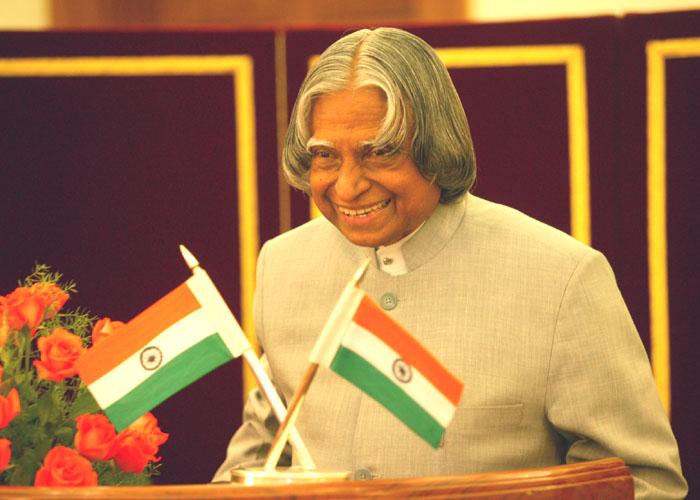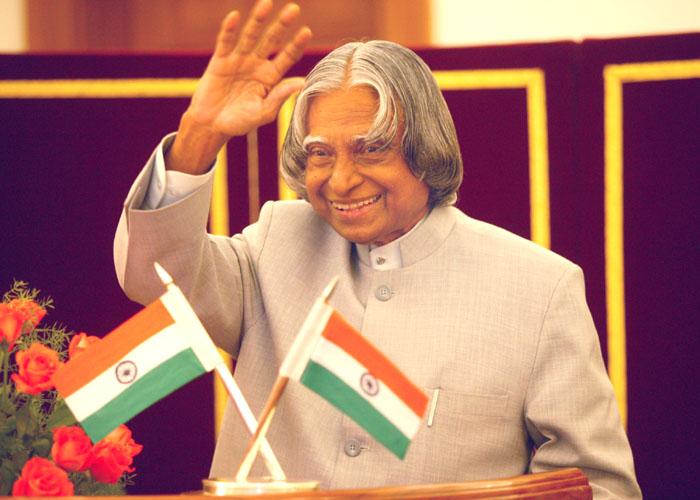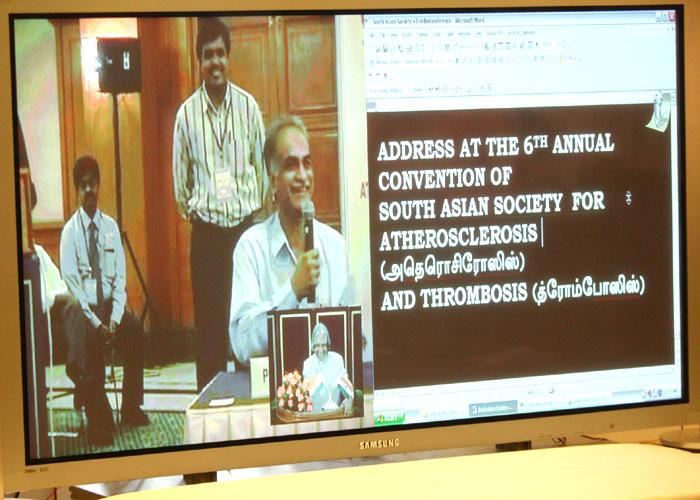Address At The 6th Annual Convention Of South Asian Society For Atherosclerosis And Thrombosis(Through Video Conference)
New Delhi : 30-10-2004
Mission towards Healthy Hearts
I am happy to address the members of South Asian Society for Atherosclerosis and Thrombosis during their 2004 Annual Convention. My greetings to the organizers, surgeons, doctors, medical scientists and technologists, pharmacologists, distinguished guests and all the participants of this Convention. Cardiac care is a vital health care area for South Asian Community. The Association of South Asian Society for Atherosclerosis and Thrombosis has to provide leadership in bringing smiles in the faces of cardiac patients. In this gathering I would like to discuss on the ?Mission towards healthy Hearts?.
Dear friends when I am in the midst of expert in the field of Atherosclerosis and Thrombosis I am reminded of the famous statement by Norman Cousins in his book, ?Anatomy of the illness? ?Patients are today reaching out to the doctor not just for medical help. They are reaching out for kindness, assurance and hope.? I would also like to share with you a quote in the paper which I came across on the topic ?One World, one people, one surgery? by Dr.T.E.Udwadia which states: ? The poorest of the poor have as much right as anyone to less pain after surgery, reduced medication, less morbidity, shorter hospitalization, and early return to home, family, and work. Minimal access surgery and the expensive technology it requires is advocated, not as homage or tribute to new technology, but in appreciation of the manifold benefits this new technology gives our patients and our people.? This thought has to be the focus of the specialist in Atherosclerosis and Thrombosis.
2. Possible Solutions
The occurrence of Cardiovascular disease is increasing rapidly, particularly in the Indian community. Multi-dimensional solutions are available for management of the diseases based on my discussion with experts. The solutions include medicinal treatment using Statins, which lowers the cholesterol in the blood by reducing the production of cholesterol by the liver. Statins block the enzyme in the liver responsible for making excess cholesterol. However one has to be careful about the side effects and take adequate precautions while treating the patients. The second is through angiography and angioplasty using stents. If the heart blockage is severe, valve defect and death of cells in the heart due to less blood supply etc., surgical intervention will be necessary. What are the future promises for treating the hearts?
(a) Stem cell therapy for future heart ailments
Newer knowledge emerging out of research on stem cells from abroad and India has to be taken note of and studied. Drawing of tens of thousands of stem cell - immature cells that are capable of transforming themselves into almost any kind of tissues from the suffering patients and inject them into the heart to stimulate heart repair. In one case, it is reported that the pumping efficiency has increased from 25% to 40% over a period of four months. In 2003, successful stem cell procedures that resulted in measurable boost in blood pumping capacity have increased substantially in many countries across the globe. This holds a big promise for effective heart repair for ailing people.
(b) Experience in stem cell: During my visit to various laboratories, I happened to see the beginning of stem cell research for different purposes including brain research. I would like to share with you an important stem cell research application in the field of cardiology. When I met Dr. P. Venugopal, Director, All India Institute of Medical Sciences (AIIMS) a famous cardiovascular and thoracic surgeon, he told me about his experiences. He said in one of the cardiac diseases, where conventional medical and surgical treatment were ineffective because of the affliction of the heart muscle, use of autologous bone marrow stem cells implantation into the diseased heart muscles had been applied in order to improve the function of heart muscle. This kind of application of this procedure is the latest and very few cases have been done in the world, the first time in India. This is expected to open new frontiers in the treatment of patients for regeneration of heart muscles, thereby giving new hope for the patients suffering from end stage heart disease.
The New Scientist (dated 25th September) has reported another remarkable recovery of a heart patient at the Johnn Wolfgong Goethe University at Frankfurt. Of course for the first time, I have come across a warning, stating that risk is very high. Against stem cell solution for every aspect of human disease, it is reported that large amount of tests on animals is needed before applying it on humans.
When we are progressing with stem cell research, it is essential to create a regulatory mechanism regarding the production of stem cell through embryo generated either from human foetus or through cloning in the laboratory. I am of the opinion that use of embryo for stem cell production in any form should be banned.
(c) Life style intervention
There is a need to propagate the importance of appropriate food habit and life style among the urban population to combat the situation of increased occurrence of heart ailment. Hospitals in the country should take proactive steps to counsel their clients in a family atmosphere for ensuring reduction in this number in the years to come. Another feature which has been noticed is that there is a competition, between cardiologists and surgeons in treating heart cases. The ideal practice should be to provide only the minimum essential treatment instead of going in for surgical intervention as a routine management of the disease.
It has been reported that the repeated occurrence of heart ailments is caused by diet, smoking, and lack of exercise and uncontrolled diabetes. All these factors can be controlled by an appropriate life style intervention. I have seen the change of life style pattern practically taking place in Global Hospital and Research Center, Mount Abu. There was a joint project of Defence Institute of Physiology and Allied Sciences (DIPAS), DRDO and the Global Hospital and Research Center for studying the effect of "holistic lifestyle intervention" on the patients suffering from Coronary Artery Diseases during the year 1997-98. The project involved both Control Group and the Experimental Group. The Control Group was subjected to conventional treatment whereas the Experimental Group was supported by an intervention involving low fat, high fiber vegetarian diet, aerobic exercises and meditation. This three-dimensional psycho-physiological mind-body approach in treating heart patients of the Experimental Group resulted in dissolution of angiographic plaque and improvement in microcirculation of blood in heart muscles of the patients. The treatment was also supported by participation of spouses and other family members of the patients, leading to a unique family system approach to Medicare.
3. Progress in Treatment of Coronary Artery Disease
We have all witnessed the treatment of cardiovascular disease moving from very invasive to less invasive methods. In the seventies bypass surgery was the big news, in the eighties it was balloon angioplasty and in the nineties it was the stent.
Now, moving a step further is a totally non-invasive treatment - EXTERNAL COUNTER PULSATION (ECP), a truly non-operative, non-pharmaceutical, safe and effective treatment which has made big news in the west. ECP is FDA (USA) approved and finds reference in medical and cardiology textbooks. Many favorable articles have been published in the Journal of the American College of Cardiology, Cardiovascular Reviews Reports, Cardiology, Mayo Clinical Proc., Clinical Cardiology, Journal of Critical Illness, Journal of External Counter Pulsation, etc. The success of ECP can be judged from the fact that in USA the insurance sector reported that the reimbursement for ECP has gone up by 6 % whereas that of other procedure like angioplasty, bypass surgery, etc. has come down by 7%. Now the treatment is available in most of the leading hospitals of the world.
In India, ECP is available at Sibia Medical Centre, Ludhiana besides Escort Heart Institute and Research Centre, New Delhi, Peoples General Hospital, Bhopal, Jamnagar etc.
It is well known that following bypass surgery - only 75% patients are symptom free for 5 years or more and only 50% after 10 years or more. The number of patients having recurrence after bypass, ballooning and stinting is increasing and for them ECP is the only FDA approved treatment available which is documented to increases blood supply to the heart by 20-42%, to the brain by 22-26% and to the kidneys by 19%. ECP also increases heart's output. More patients now prefer non-invasive treatments. With improved cerebral circulation patients may notice improved memory, etc. Annual Convention may like to study this technique of ECP EXTERNAL COUNTER PULSATION
4. Research in Gene Chip
Indian population is highly susceptible for coronary heart diseases that too at a relatively young age irrespective of where they live. As you are aware, Gene Chip arrays have tremendous potential to reach goals from identifying genetic variations associated with heart disease for discovering new drug targets.
Recently, I was in Chennai at Dr. Cherian?s Medical Centre. It is known as, International Centre for Biomedical Sciences and Technology (Research & Applications). There I interacted with Dr. Emmanuel, who is working in the area of Gene Chip. He says the Gene Chip can be used for finding the existence of genetic diseases including coronary artery diseases in the baby during a certain stage of pregnancy itself.
As many as 50 different mutated genes are identified as responsible for heart problems in Indian population. If a person is not having any of these harmful mutated genes, then he may not suffer from heart ailments. The Gene Chip is one which on contacting with the blood, immediately identifies the mutated genes in the person. Based on this information, proper guidance can be given to the patients and parents. The chip could also be modified to suggest to the patient?s system to develop those chemicals which in turn will help the patient recover from the present situation.
It is reported that gene differences between humans and most animals are very nominal. More than 90% of our DNA is similar. This property is a boon to researchers since animal models can be subsequently used for curing human diseases based on trial data. It has also been found that Gene Chips can be used for early diagnosis of tumors and their treatment. Integrating molecular biology, cytogenetics and bio-chemistry, bio-chip technology is regarded as one of the important inventions in the research of gene functions. It is far superior to molecular biological technology in terms of speed and accuracy. I would recommend the medical researchers to progress further in this area for finding the application of Gene Chip as a diagnostic tool and as a treatment regime for many diseases.
5. Conclusion
As we have discussed, Gene Chip, Stem Cell research and EXTERNAL COUNTER PULSATION have applications for many diseases relevant to India particularly cardiac diseases. We have to recognize another potential area of research of nano-science which has already entered into diagnosis and treatment of diseases , particularly relating to brain cancer and heart. It is predicted that nano-robots will carry diagnostic probe and treatment solutions. Finally the robots will get digested in the human system after curing the disease. Sometimes I feel that the world may declare the early phase of twenty-first century, as a century of nano-science research and technology leading to revolution in human life enrichment. I would recommend the following six suggestions for the members of South Asian Society for Atherosclerosis and Thrombosis:
a. It is essential to work on stem cell research in relation to end stage heart diseases.
b. It is essential to identify a specific research area for combating problem associated with Atherosclerosis and Thrombosis. One of the solutions may be Gene chip.
c. The doctors as teachers have to propagate the importance of life style change towards fibrous vegetarian food, aerobic exercises and meditation.
d. The urban population is the most affected by A and T diseases compared to rural population. Researchers have to identify the exact reasons for low and high incidence.
e. Every nation of south Asian countries may have core competence in certain areas. This should be identified and combined. This multinational cooperation can lead to projects in medical area for development and production of cost effective diagnostic tools medical equipments and medicines.
f. Clinical data from south Asian nations for a particular cardiac disease is a very important database for research. I would suggest that there should be tele-connectivity between medical research centers of south Asian countries for sharing experiences.
My best wishes to you all.
May God bless you.
Question and Answers Session
1. India has emerged as IT superpower. However most of scientific information emerges in the West. Also, there is so much happening in India but there is an absence of perspective. Would Mr. President arrange marriage of the Indian IT with Western Scientific Knowledge?
- Dr. Vijay Kakkar, London, UK (Indian)
Ans. We in India, Prof MGK Menon team have brought out the IT policy with 112 recommendations. Government accepted most of them. I personally believe, World is entering from information society to knowledge society. Knowledge society is driven by the innovation. Innovation starts from quality of education and the incentives for the innovation. There are certain areas; India can definitely contribute to world community. We have to evolve mission oriented organizations. Wherever the Mission orientation is in focus, we have succeeded.
2. There is growing incidence of Coronary Artery Disease in Indian Population. It is a scientifically established fact now that Indians are genetically predisposed to Heart Disease. Sir, it is very important that education about correct life style and nutrition get in to the education curriculum. Such things take very long time in India and many times not happen at all. Will Mr. President ensure that?
- Dr. Omar Iqbal, Chicago, USA (Indian)
Ans. Some research work has been done, particularly relating to the recurrence of heart diseases, post by pass surgery, post angioplasty and stenting. The three dimensional approach are fibrous vegetarian food, aerobic exercises and meditation.
3. President Sir, my country is facing lot of sanctions from the West. You had your own experience of facing sanctions and defeating them. Our Chairman H.E. Gen. Than Shwe visited Mr. President recently. We have problems in getting medical equipment and products. Are you going to support us?
- Dr. Tin Maung Aye, Yangon, Myanmar.
Ans. We can be partners
4. My Role model is Mahatma Gandhi. He accomplished impossible through peaceful means. I hate to be political Mr. President but why prominent religious leaders in the world care silent and meek spectator of war and violence? You are like a second Gandhi Mr. President; will you please accomplish the impossible?
- Dr. Nasrin Dashti, Alabama, USA (Iranian)
Ans. We have started the movement recently in Gujarat ? called ?Surat Spiritual declaration?.
5. There are not many opportunity for higher education in Pakistan. Not many students can afford education in Western Universities. Would Mr. President consider opening up of Indian Universities for Pakistani Students, particularly at the PH D level?
- Dr. Javed Ismail, Karachi, Pakistan.
Ans. Definitely it is possible, when the SARRAC countries meet this can be discussed. I will work for it.
6. Mr. President, prevention is the most feasible and attractive option for control of heart disease. Economies of the developing countries can really not support treatment of heart disease. Would you, Mr. President, be a role model and champion of Preventive Cardiology in the developing world?
- Dr. Shanti Mendis, WHO,Geneva, Switdzerland (Sri Lankan)
Ans. In India, AIIMS, Delhi and also the Global hospital and research centre at Mount Abu, both have come out with 3 dimensional model ? a life style change that will lead to reduce incidence of heart problems. However, every cardiology practitioners to become a teacher to the patients.
7. There is growing concern about availability of medical help to aged people. People say they respect their elders but hardly anyone supports them. Mr. President! Would you lead an International Campaign for the healthcare of the Aged?
- Dr. Umberto Cornelli, Milan, Italy.
Ans. I am encouraging and supporting both national and international agencies and also I will assist a parliamentary bill in our country.
8. By reading Wings of Fire, I learned your experience that success comes out of effective leadership, dedicated staff, and support of the Government. Similarly in the management of Cardiovascular Disease we need leadership, network and national platform. Sir, handling of Cardiovascular Disease is indeed a very big mission. I am afraid not much is happening in developing world. We are approaching a human disaster. Will you kindly be the Mission Director?
- Dr. H. Gudu Rao, Minnesota, USA.
Ans. I will be completing my tenure by July 2007, I want to go back to my teaching profession. You have given me a suggestion, definitely you have given me a suggestion, If you all want I will take it up.



